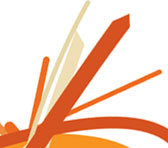17 August 2009
Les Millar
Adelaide // SA // 20.07.2009

Les Millar is a renowned Australian composer and songwriter whose performances incorporate a combination of vocals, double bass, guitar and percussion instruments. Millar essentially multitasks with his arsenal of instruments, creating a sonic backdrop of textures, rhythms and melodies using digital looping technology in consort with his instruments.
Digital looping technology has been in vogue amongst musicians in recent years. Each generation has been willing and able to incorporate new technologies into their work, for instance the Adelaide-based Adam Page has gained acclaim through his creative application of looping devices in a live context. Over the past decade, affordable music technology has flooded the market and found its way into performance and studio environments.
In a live context, looping technology has great potential, both in terms of musicality and economy. It presents the musician with choices that would be otherwise unfathomable, chiefly by eliminating the hassle of working with additional musicians and making it possible to self-govern the performative process. One might think of this as the (techno)logical extension of the famous ‘one-man band’ with their kick drum, cymbals, guitar and assorted musical paraphernalia. Of course, performing with multiple instruments and looping is no mean feat, and an individual with a good sense of timing and structure is required to pull things off adequately.
Millar’s performance was an eclectic mix of styles, ranging from progressive pop-folk and pseudo-world music to jazz improvisations and an intriguing foray into scatting and proto-rap. Throughout the performance, Millar’s double bass dominated as the staple instrument, whilst occasionally voice and percussion were added into the mix.
The performance began strongly as Millar, using his looping effects and a short echo delay, created clouds of harmonic and percussive textures with short pizzicato and long bowed notes from his double bass. Momentum gathered gradually, as a familiar melody was played against this repetitive pattern and Millar sung a short passage about the emergence and beginning of things, building to a gentle crescendo before finishing abruptly. It was a very impressive opening, stylistically reminiscent of the late American cellist Arthur Russel, whose works combined classicist sensibilities fused with modern electronics.
The next couple of songs followed a similar tract, a process of building layers of instrumentation and then playing and singing live against the sonic backdrop. One of these songs, 'Road To Malawi', took on a distinctly African feel and reflected on Millar’s childhood journeys home to Malawi. With a solid bass melody, polyrhythmic textures and an infectious vocal melody, the track highlighted Millar’s competence in handling his instrumentation and the looping process with efficient execution and timing. As Millar’s set progressed, the material began to veer into more traditional jazz territory, and whilst the overall set was enjoyable, at times it seemed to meander and pale slightly in comparison to the entertaining and exuberant opening songs.
A redeeming aspect of Millar’s performance was in his skilful use of technology. It was incorporated into the performance without making a spectacle of it - an all too familiar problem. Instead, emphasis was placed on the music and the technology performed its role as a tool, without making itself blatantly obvious.
It is encouraging to see a performer, synonymous with the Australian jazz scene, willing to demonstrate their stylistic dexterity and eclectic interests. This individuality was the most entertaining aspect of Millar’s performance (specifically the first half of his performance) and provides evidence of his technical ability as a musician.
Event details
Les Millar - Strange Overtones
COMA Hipnote Sessions
Wheatsheaf Hotel, Thebarton, SA
20 July 2009
Further links
Creative Original Music Adelaide COMA (http://www.coma.net.au/)
© Australian Music Centre (2009) — Permission must be obtained from the AMC if you wish to reproduce this article either online or in print.
Subjects discussed by this article:
Tristan Louth-Robins is a South Australian sound artist, visual artist and composer. Since 2006 he has been the curator of the Tyndall Assembly experimental music series which showcases the work of local artists and composers. He is currently completing a Master of Music at the Elder Conservatorium, University of Adelaide, where he also teaches within his department of Music Technology. He is also a member of the electronic music group Panoptique Electrical.
Comments
Be the first to share add your thoughts and opinions in response to this article.
You must login to post a comment.